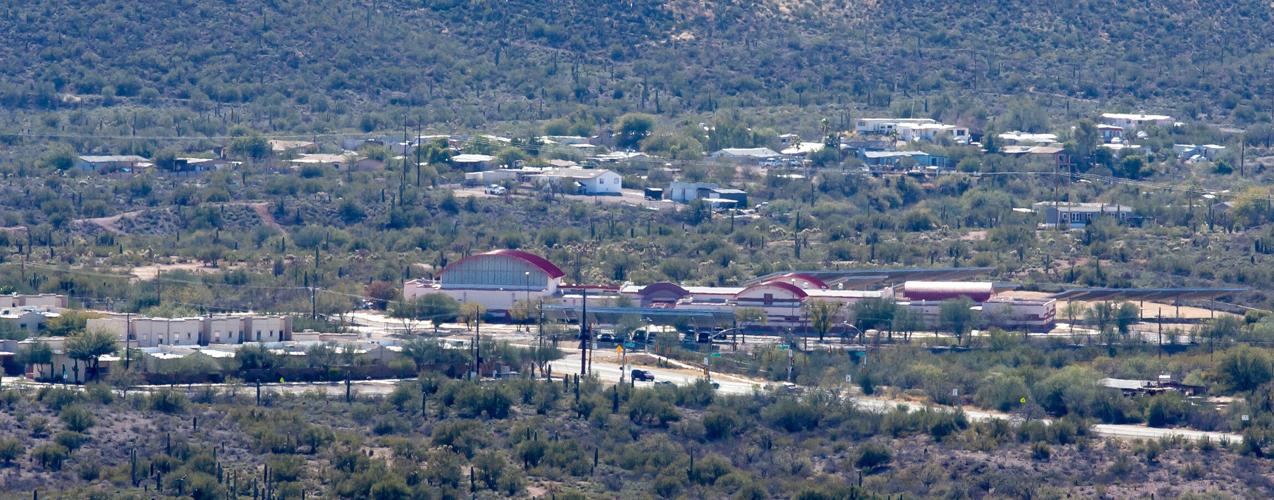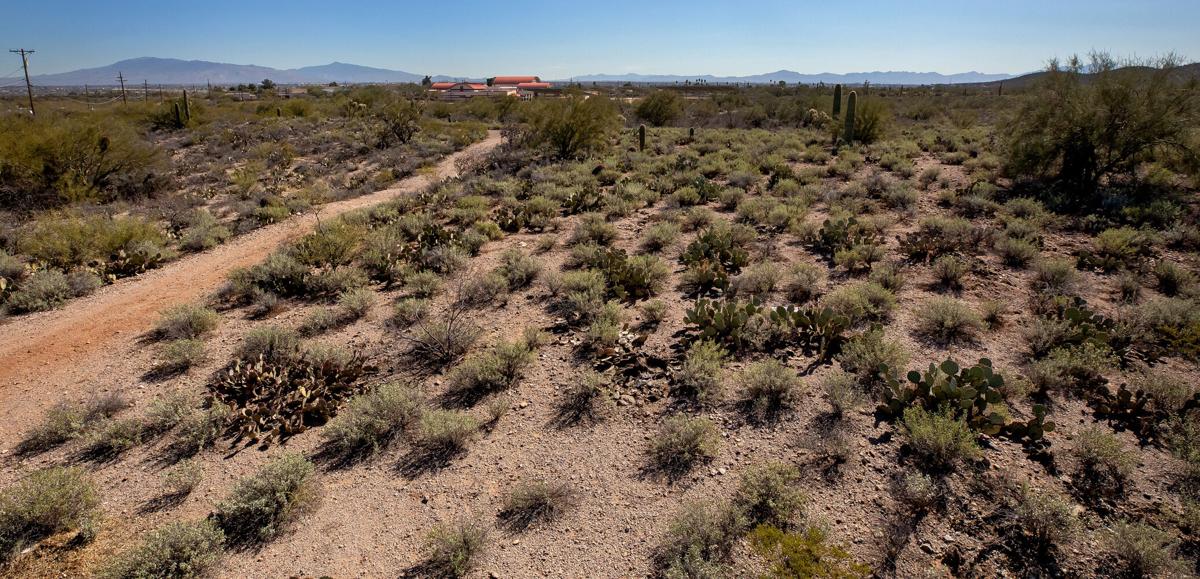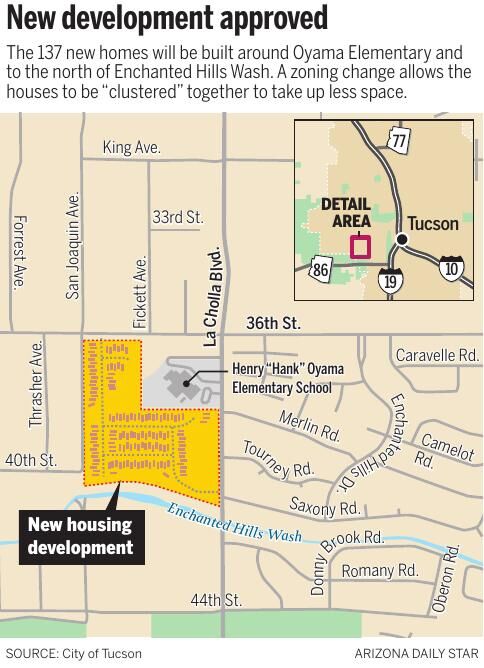Tucson City Council members approved a controversial new housing development Tuesday, a move that is expected to create about 137 new homes on 60 acres of property near South La Cholla Boulevard and West 36th Street.
The area is a largely untouched piece of Sonoran Desert that is situated between sparse neighborhoods to the north and west, undeveloped land to the south and a dense suburb to the east. Locals have protested the new development for years, saying it would wreak havoc on nearby wildlife and change the neighborhood’s character by taking up the open space that has defined it for decades.
But city officials said their hands were tied: The land is privately owned by a limited liability company called Buena Vista Properties 2000, which may have still been able to build over 100 homes on the property without receiving any special permission.
Council members instead voted 5-2 to adopt a compromise plan that is expected to leave 70% of the area undisturbed.
The agreement also required the property owner to build some affordable housing units, capped the total number of homes that are allowed to be built and limited the construction of two story structures in an effort to preserve more open space.
“What we have in front of us is the most responsible action we can take,” Mayor Regina Romero said. “I would love an open space park here, but the reality is that this particular piece of land is owned by someone. That someone is not Pima County, that someone is not the city of Tucson, and that someone is not me. If I were the owner I would love to be able to protect this piece of land, but that is not the reality that we’re living in.”
Ahead of this week’s vote, existing zoning rules still would have allowed the property owner to build two homes on each 36,000-square-foot lot.
That shakes out to between 110 and 144 housing units spread out over a massive area, which forced Tucson to the negotiating table. City staff said it would have “destroyed everything” in the surrounding landscape.
“They could have come in at any time and done a large subdivision without going through any process,” said Scott Clark, Tucson’s Planning and Development Services director.
Officials made a zoning exception for the company that allowed it to build homes closer to one another, called “cluster development,” in order to keep the area as open as possible.
City staff also said it reduced the environmental impact of the project, though it’s still expected to uproot hundreds of saguaro cactuses that will need to be replaced three times over, according to a separate law.
“We’re going to destroy hundreds of saguaros. That gives me a real problem,” said Councilman Steve Kozachik, who voted against the plan. “The replacement ratio is three per one. If we destroy 200, that means they’re going to have to transplant 600 of these things somewhere. I haven’t heard or read anything about that being addressed.”
Kozachik raised another concern about the cluster development strategy. It pushed all of the new housing units to a smaller area next to Oyama Elementary School and north of the Enchanted Hills Wash, which runs through the middle of the property.

The empty lot behind Oyama Elementary School, center, will become a new housing development.
Developers abandoned plans for construction on the south side of the wash as one of their concessions. It’s one of the reasons that 70% of the total area will remain undisturbed under the new plan, but the Ward 6 councilman said it wasn’t actually a compromise.
“That southern portion is largely unbuildable anyway because of the topography and the floodplain,” Kozachik said. “Moving to the north is not a concession, it’s where this was headed all along because they couldn’t have built on the south.”
If Kozachik is correct, it would mean that the future development could have been much smaller if the zoning tweak had not been approved.
Councilman Kevin Dahl also voted against the new plan because he said the city was breaking a promise it made to preserve the area when it was annexed more than four decades ago.
“The most compelling issue for me is that the city made an annexation promise to the surrounding residents when the parcel was brought into the city,” Dahl said. “I feel going back on the city’s promises is a disservice to the current residents and will impede future attempts at annexation.”
Vice Mayor Lane Santa Cruz, who spearheaded the negotiations and public outreach efforts for the development, pointed to the increase in housing options as a win for the city.
The agreement requires the property owner to construct 14 affordable housing units as part of the development. The other 123 homes being built on the site will also boost Tucson’s short-supplied housing stock, one of the most significant issues the city is currently facing.
“These types of decisions often feel like a choice between competing needs. How do you balance environmental protections and the need for housing?” Santa Cruz said. “The type of infill development proposed on this site meets the need and encourages the continuation of mixed income communities by setting aside 10% of the lots to be developed as affordable housing and protecting the natural open desert south of the wash.”
26 photos of Tucson's quirkiest saguaros
Tucson's quirky saguaros
Updated
You can find this crested saguaro near the entrance to the Arizona-Sonora Desert Museum.
Tucson's quirky saguaros
Updated
A rare crested saguaro stands on a slope above the Pima Canyon Trail.
Tucson's quirky saguaros
Updated
This crested saguaro beside Old Main on the University of Arizona campus appears to be signaling a touchdown.
Tucson's quirky saguaros
Updated
This photo was taken in Ironwood Forest National Monument, west of Marana.
Tucson's quirky saguaros
Updated
A Gila woodpecker prepares to pop into its nest on a crested saguaro at Tucson Botanical Gardens, Tuesday, June 1, 2004.
Tucson's quirky saguaros
Updated
This cactus was spotted west of Green Valley.
Tucson's quirky saguaros
Updated
A little saguaro has found its niche between a rock and a hard place along the Esperero Trail in Sabino Canyon.
Tucson's quirky saguaros
Updated
Many saguaros make a big thing of symmetry and perfect form. And then there's this one.
Tucson's quirky saguaros
Updated
Distant finger rock is framed by the almost circular strands of a dead saguaro.
Tucson's quirky saguaros
Updated
A Saguaro the looks like a dinosaur (Tyrannosaurus Rex) near Ridgeside Drive near Sediment Drive on Jan. 21, 2013.
Tucson's quirky saguaros
Updated
An old multiple arm saguaro appears to ready to topple over Friday, Sept. 10, 2004 near Teal Blue Trail and Moore Roads.
Tucson's quirky saguaros
Updated
Scenery along the Valley View Overlook Trail at Saguaro National Park West on Dec. 15, 2010.
Tucson's quirky saguaros
Updated
A saguaro appears to embrace the sunset in Sabino Canyon along the final stretch of a hike on the Phoneline Trail. Photo taken January 10, 2015. Doug Kreutz / Arizona Daily Star
Tucson's quirky saguaros
Updated
A crested saguaro with numerous arms soaks up the sun on the city's northwest side. Crested saguaros are quite rare happening only 1 in 10,000.
Tucson's quirky saguaros
Updated
This saguaro, along the Mica View Trail at Saguaro National Park east of Tucson, was leaning at a precarious angle before it fell to the ground in early 2015. Photo by Doug Kreutz / Arizona Daily Star
Tucson's quirky saguaros
Updated
This cristate, or crested, saguaro in Sabino Canyon near Tucson is putting on a good bloom. Photo taken June 3, 2014. Photo by Doug Kreutz / Arizona Daily Star
Tucson's quirky saguaros
Updated
A rare crested saguaro in Sabino Canyon near Tucson has plenty of blooms and buds this spring. Photo taken June 3, 2014.
Tucson's quirky saguaros
Updated
A prickly pear cactus is growing out of a saguaro in the Desert Garden area along the Bajada Loop Nature Trail in Sabino Canyon northeast of Tucson.
Tucson's quirky saguaros
Updated
A Saguaro cactus on Soldiers Trail Road that looks like an elephant in 1973. The Tucson Citizen called it a "Saguarontosaurus." "This spiny antecedent of the ponderous pachyderm stalks the desert east of town," the newspaper wrote. Tucson Citizen file
Tucson's quirky saguaros
Updated
A fountain shaped like a saguaro cactus stands in front of a real cactus at a home in Dove Mountain on Aug. 31, 2010.
Tucson's quirky saguaros
Updated
Saguaros stand against a sky of patchy clouds Thursday afternoon on July 31, 2003 at Saguaro National Park near Tucson, Ariz.
Tucson's quirky saguaros
Updated
A rare tri-crested saguaro seems to be waving in the Tortolita Mountains on Jan. 3, 2002.
Tucson's quirky saguaros
Updated
A saguaro wears a bikini outside a Pizza Hut at East Sunrise Drive and Swan Road June 17, 1997.
Tucson's quirky saguaros
Updated
This rider has a cute little Saguaro cactus with a golf ball hat on his helmet during El Tour de Tucson on Saturday November 19, 2011, in Tucson, Ariz.
Tucson's quirky saguaros
Updated
A rare crested saguaro cactus stands on the land of the 2,073-acre Green Valley preserve Oct. 7, 2007 in Green Valley, Ariz.
Tucson's quirky saguaros
Updated
A prickly pear cactus and another cactus grow out of one of the scars on the side of the transplanted saguaro Monday Sept. 9, 2002.







